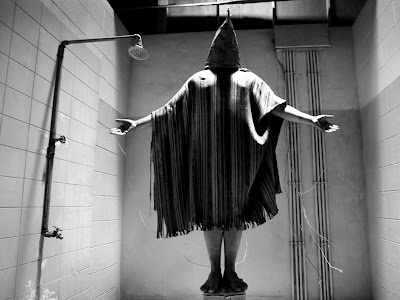Photography
serves as a method of communication and conveys a general message to viewers by
using unique elements to grab their attention. When analyzing photography,
viewers can study the picture as a whole and absorb its overall message; while
on the other hand they can also be captured by a prominent element in the
photograph that has a story of its own. In his book Camera Lucida Roland Barthes states, “It is by studium that I am interested in so many photographs, whether I
receive them as political testimony or enjoy them as good historical scenes”
(Barthes 26). The studium that
Barthes refers to in this context includes all the elements of photographs that
develop a general interest for the viewer. Only an average effect can spark an
interest in viewers have towards the studium.
However, the element that breaks the studium,
rises from the scene, shoots out like an arrow and pierces the reader is known
as the punctum (Barthes 27). In other
words, the punctum is the prominent
element in the picture that intrigues viewers and conveys a unique message.
This blog will encompass the theories of Roland Barthes to display how the punctum dominates the studium and successfully captures the
attention of viewers.
 |
| Picture of Columbian woman praying in Church 2012 Time Magazine |
The
punctum enhances certain images which
are dull and possess no creative meaning into interesting photographs that
convey strong messages and impresses viewers. The photograph from the Time
Magazine of the Columbian woman praying in church initially presents itself with
only the message that the woman is possibly facing oppression and hence seeking
solace from god. This is the studium.
Roland Barthes states, “News photographs are very unary. In these images, no punctum: […] I am interested in them, I
do not love them” (Barthes 41). Barthes makes it clear that news photographs
only serve the purpose of visually displaying the occurrence of a certain
event. In his view, they do not have a punctum
or a certain element that stands out to arouse the viewer’s curiosity. However,
when analyzing the picture of the Columbian woman in the church, the light
distribution in the picture and the position and clothing of the woman stand
out and serve as the punctum. The
woman is wearing white and stands next to the pulpit. The shadow of the pulpit
covers her and everything in front of her. Since viewers observe the picture
from a rear view, they identify that the window is open and that everything
behind the woman is lightened while the area where she is standing including everything
in front of her is darkened. Her white clothing and stance display a sign of
purity and convey to viewers that she is seeking solace. Simultaneously, the
lighting divides the photograph into two parts outlining how the Church and
state are separated in Columbia and how the older ways of seeking divine help
is in the dark while there is light shed by society on practical solutions
rather than divine faith. Such elements of the photograph draw viewers’
attention and provoke them to analyze it with a different perspective.
 |
| Prisoner at Abu Ghraib Prison in Standard Operating Procedure. 2008. |
Specific
parts of the photograph that serve as the
punctum contribute more to the meaning of the photograph than its other
parts do. Barthes states that when underwear is worn in a unary pornographic
picture, “the photograph is no longer unary, since I am interested in the
texture of the material” (Barthes 42). Barthes is interested in how the
photograph deviates from the normal and includes a new aspect to analyze in the
photograph rather than just the obvious theme in pornographic pictures – sex.
In the picture of the man being punished in Abu Ghraib Prison, his attire and
the fact that his face is covered, act as the punctum while all the other aspects of the element display one
obvious message – he is being relentlessly tortured. His position is similar to
how one would be crucified and electric wires are attached to his hands.
However, what stands out is that his face is not being shown in the photograph
and he is just dressed in what seems to be some cloth that could have served as
a bed sheet. The punctum here
triggers the question of whether the man is trying to be hidden by others or
whether they consider him unworthy of being revealed. The punctum dominates all other aspects of the photograph and inserts
itself in the mind of the viewer. Hence, viewers realize that the punctum presents itself as the prominent
element of the photograph and contributes greatly to the meaning of the
photograph.
- By Ahdil Hameed
Works
Cited
Barthes, Roland. Camera Lucida: Reflections on Photography. New York: Douglas &
McIntyre, 1980.

No comments:
Post a Comment